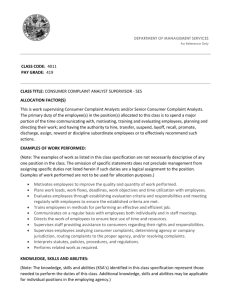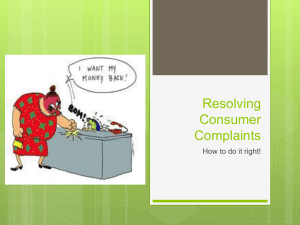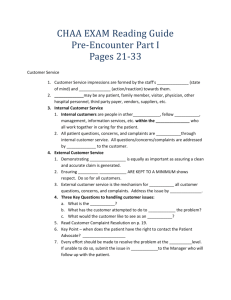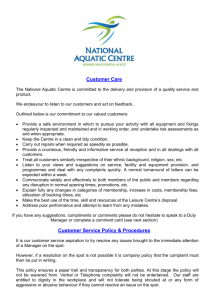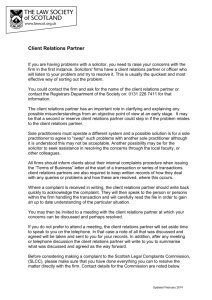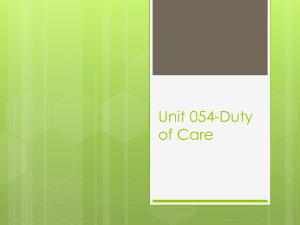Compendium of Practices on Community-Based
advertisement
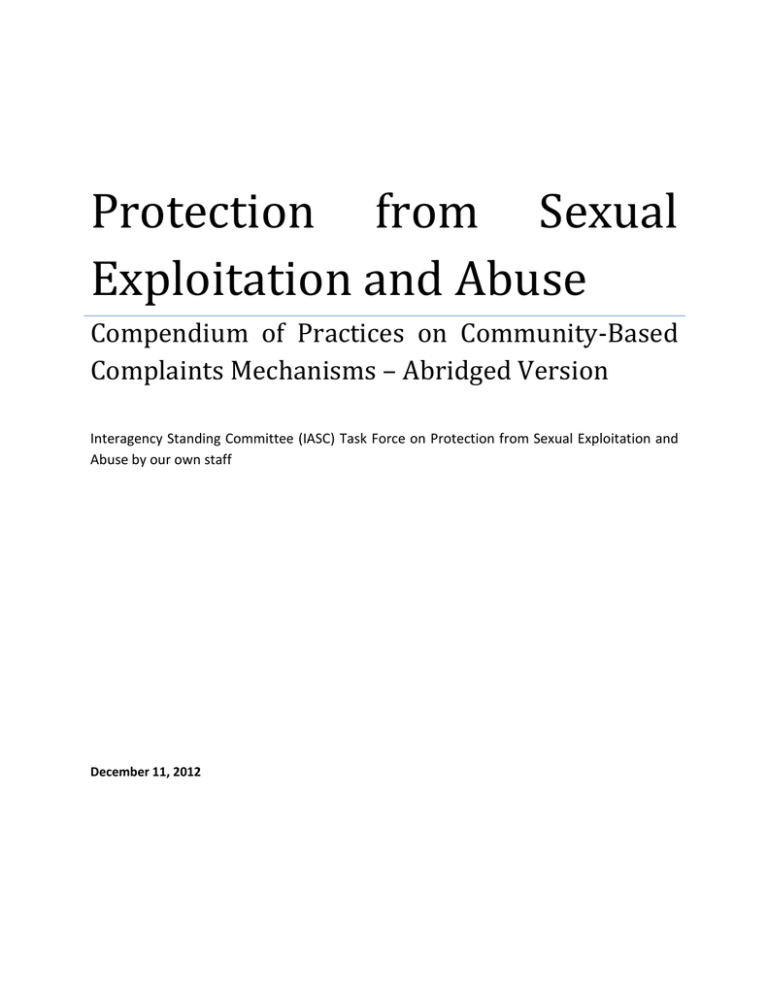
Protection from Sexual Exploitation and Abuse Compendium of Practices on Community-Based Complaints Mechanisms – Abridged Version Interagency Standing Committee (IASC) Task Force on Protection from Sexual Exploitation and Abuse by our own staff December 11, 2012 Executive Summary The exercise of compiling practices related to the community-based complaints mechanisms (CBCM) focused on sexual exploitation and abuse (SEA) by humanitarian or development workers confirms what many agencies have already observed as a weakness: CBCM, particularly those of an interagency nature, are rare. Indeed, despite the momentum created by the issuance of the UN Secretary General’s Special Bulletin on Sexual Exploitation and Abuse in the wake of the West Africa scandals, relatively few collective endeavors to create safe and accessible interagency avenues for beneficiaries to raise a concern or lodge a complaint regarding staff involvement in abuse of beneficiaries have been established. This is in part due to the fact that the humanitarian and development sectors recognized quickly that establishing CBCMs focused exclusively on preventing sexual exploitation or abuse, and advertizing them as such, seems to dissuade rather than encourage reporting by beneficiaries. Nevertheless, despite a sector-wide focus on the issue, increased donor scrutiny, incidents dissected in the media, and repeated calls for improvements, interagency CBCMs remain few. As a consequence, there is little experience and data to draw upon in the analysis of what does and doesn’t work in terms of CBCMs, which seek to root out the problem of sexual exploitation or abuse by staff members. Inter-Agency and Internal Complaints’ Procedures Fortunately, individual agencies have sought to implement complaint mechanisms as part of their programming. Coupled with growing knowledge and interest in the field of accountability to affected populations, the small number of PSEA-focused CBCM initiatives has generated at least some instruction on how complaint mechanisms can be effective and sustainable. For instance, opting for interagency complaints mechanisms rather than relying on individual agencies to operate their own, is a tremendously important lesson learnt. The experience of certain CBCMS suggests that their interagency aspect is precisely what facilitates and encourages reporting by beneficiaries, or even whistle blowing by agency personnel. This in no way dilutes another extremely important lesson, namely that clear internal complaints procedures are just as important as having interagency systems for receiving such complaints. Indeed, the lack of an understood or functional internal system for managing complaints in just one agency can jeopardize the credibility for multiple agencies, all the more so if that agency is participating in an interagency community-based complaints mechanism. Thus, and somewhat ironically, individual agency complaints management systems are just as important as interagency CBCMs; the former being fundamental to the success of the latter. Practices to Keep Positive practices include the adoption of common codes of conduct by participating agencies in a specific operational setting. This has helped hold a wider number of staff accountable in a specific location while projecting a common set of standards to the beneficiaries being served. Having such common codes or standards in place renders training of staff from multiple agencies that much easier and consistent, reinforcing understanding as well as a sense of ownership. Another good practice is the use of knowledge attitude and practice (KAP) surveys before, during, and after an initiative to address 2 SEA. While such surveying permeates the humanitarian sector, notably in health and WASH sectors, it has been rarely used for examining the reporting (or non-reporting) of staff misconduct. This is unfortunate given how informative this is in understanding local handling or processing of sensitive information. Similarly, surveying of beneficiary satisfaction before or after a CBCM project has rarely been carried out but can yield precious information for refining, improving or sustaining a complaints mechanism. Both KAP and beneficiary satisfaction surveying also have the added benefit of allowing beneficiaries additional opportunities for disclosing situations or incidents. Another strong practice, which must be considered for any future CBCM project, is the practice whereby independent complaint handling committees or clearinghouses form an integral part of the complaints mechanism itself. An independent clearinghouse entity, not affiliated with a single agency, tasked with the responsibility of receiving and referring reports to the appropriate agencies helps reduce the time and even subjectivity with which agencies may process incoming reports. It can reinforce the neutrality and the all-important perception of independence or objectivity of the complaints mechanism. Practices to Change The practices that have not been successful in the implementation of PSEA-focused CBCMs do not come as a surprise. The first lesson is that there is still insufficient consultation with the beneficiary community in the establishment of CBCMs, especially in the early stages of such an initiative. While there has been some consultation in certain projects, it seems insufficient in terms of designing the CBCM to the needs to the community using it and to the trust necessary for operating it. This, however, seems to apply almost exclusively to interagency CBCMs and not to individually operated complaints mechanisms, which are more often based on a consultative processes with the community served. Closely related to this poor practice, is the absence of better or closer relations with community-based organizations (CBO) in the design on the CBCM as well as its operation. Though they vary in size, mandate and structure, CBOs often enjoy greater trust within communities and can provide the bridge that agencies, especially larger organizations, need to deliver aid or assistance. Neglecting to involve them in the design of a mechanism means losing opportunities to develop relevant complaints mechanism as well as evaluating them as they evolve. Crucially, CBOs may bolster the sustainability of a CBCM and should therefore be more intimately involved in the development and operation of CBCMs by NGOs, INGOs or UN agencies. Another weakness in addressing SEA is the lack of a strategy for tackling rumors or hearsay within communities and the workplace. This lack of strategy stands in contrast to the clarity with which many agencies will approach official complaints or concerns. Though not a practice per se, this pattern of negligence towards rumors is unfortunate because SEA, like other types of staff misconduct, usually surfaces first as rumors before being reported by way of an official channel. Given the sensitive nature of SEA, it stands to reason that agencies and interagency CBCMs should adopt a more proactive approach to rumors, rather than wait for the rumors to reach them or be captured in an official incident report. There are, of course, challenges to such a proactive approach, namely that pursuing rumors may generate a false impression of guilt or have unintended consequences. Still, however, the current of practice of waiting until a rumor is brought to a complaint mechanism by an actual person hampers 3 successfully addressing SEA. There is a sector responsibility to more actively assess or tackle rumors as opposed to letting them fester and jeopardize the CBCM. Certain practices may be fundamentally sound but require change or simply better implementation if CBCMs are to be used effectively for reporting SEA. The use of complaints boxes, in particular, illustrates this point. By general agreement, complaints boxes established for reporting SEA or other forms of misconduct, or even general protection issues, do not function well and increase protection risks instead of reducing them. Furthermore, feedback from some beneficiary populations is that complaints boxes constitute a “black hole” into which complaints or feedback disappears forever without getting proper attention. The improvements therefore are at the level of how the boxes are advertized and, perhaps more importantly, how they are managed. What clearly must be avoided is that boxes are used in isolation without any indication to the community of when they will be opened and the complaints processed. Without a clear management plan for the boxes, the complaints boxes may falsely raise hopes and jeopardize beneficiaries’ willingness to report exploitation or abuse by a staff member. As such, complaints boxes are a practice that requires improvement. Practices to Consider Finally, the field of community-based complaints mechanisms remains a new one in which agencies and workers alike are still learning what works best and what lessons from other fields can be applied to CBCMs focusing on PSEA or staff misconduct. In this spirit, it is worth considering what practices should be used in the future. Here, we point to basic technological solutions already applied in protection programming such as texting reports of protection-related incidents or using web-based reporting channels. Obvious limitations in terms of accessibility to phones or the Internet exist but as this accessibility increases, the humanitarian sector would do well to consider their use closely, particularly on an issue which can require anonymity or heightened confidentiality. 4 Practices to Keep Clear internal complaints and management system Before agencies seek to jointly establish community-based complaints mechanisms, it is fundamental that they have an internal complaints reporting and management system already in place. Internal channels for escalating a complaint or a concern must be established, accessible, consistent, and most importantly understood by all levels of staff. While many agencies may already have a code of conduct describing allowable and prohibited behavior, it remains unclear to many staff what the internal processes for lodging a complaint may be or what steps should be taken if information is received by an outside source (whether from the beneficiary community, partner organization, concerned individual or any other external entity) regarding staff misconduct. Such internal mechanisms may vary from agency to agency, depending on size, structure, mandate, and other organizational aspects, but generally must feature several core elements. First, multiple channels for signaling a complaint or concern must be in place – internal mechanisms must never offer only one avenue or channel to a staff member for reporting a concern. One of these channels should offer anonymity. Second, such internal mechanisms should always clearly identify the roles of the persons involved in the complaints management process. Again, these roles may vary enormously from organization to organization but must be made abundantly clear to those who are meant to assume them. Usually, this means guidance for supervisors receiving concerns or persons identified as focal points for receiving such concerns or complaints, responsibilities for managers when a complaint has been lodged, the duties of any person involved in an investigation of a complaint. Third, internal complaints management systems should have clear communication strategies for the management of complaints, i.e. what information will be shared with the complainant, witnesses, and subject of complaint. This also includes strategies for sharing information with other staff or personnel. Finally, whatever the internal mechanism may be, it is absolutely essential that it is understandable and accessible at the local or field levels. Without a clearly defined and functional internal system for handling complaints internally, an agency may not be able to effectively Examples of internal complaints management systems Danish Refugee Council Complaints Mechanism Handbook See Sections 2 and 3 in Concern Pakistan CRM for Program Participants Concern Worldwide West Darfur Programme Fact Sheet See Complaints Handling System in Concern Kenya CRM Guide Concern DRC – Guide Pour le Mécanisme de Traitement des Plaintes Masisi People in Aid – Policy Guide and Template Whistleblowing Oxfam GB - Complaints Hotline Protocols Worldvision Community Complaints & Feedback Field Policy & Procedures Manual See Procedures and Response in ECB The Good Enough Guide. 5 participate in a joint community-based mechanism with other agencies as it will be unable to process complaints received, whether they concern their own staff, that of others or beneficiaries. Furthermore, an agency lacking clearly defined internal mechanisms or steps may place in jeopardy the entire joint initiative as poorly or inconsistently handled complaints will harm the credibility of the joint complaints mechanism in the eyes of beneficiaries and other agencies. 6 Joint or Interagency Complaint Mechanisms Generally speaking, any mechanism that seeks to be based at the community-level should involve the participation of all agencies present in that location, even if interaction between those agencies is rare. Agencies and previous CBCM experience indicate that the interagency nature of a complaint mechanism can offer advantages Examples of joint or interagency over individually operated ones. The first advantage is that a joint complaint mechanisms and mechanism offers the beneficiary complainant (or even a protocols complainant staff member) the option of complaining to an agency which does not itself employ the alleged perpetrator of the Kenya - Standard misconduct. In this way, a joint mechanism can reduce fear of reprisal and offer more comfortable options for a complaint to be made. Operating Procedures Another advantage is that, as beneficiaries cannot or do not for PSEA necessarily distinguish between humanitarian workers employing Thailand - CCSDPT agencies and therefore may not distinguish which agency misconduct Interagency PSEA of a staff member should be reported, a joint mechanism allows reports made to any of the participating agencies to reach the Protocols appropriate agency. This is ensured usually through the adoption of Haiti - Description of a interagency protocols which govern how these referrals should be proposed joint made; the modalities of such a system may vary according to the number, type, and size of the agencies participating as well as the mechanism in Haiti nature of the assistance being delivered/context in which the CBCM Haiti - Setting up a is operating. Some CBCMs have opted for a referral system between Joint Mechanism in the agencies while others relied on a clearinghouse system and/or Haiti established complaints committees, which receive and refer reports to agencies. Related to this, interagency protocols also offer a See Set Up a practical accountability tool. Indeed, the referring agency and/or Complaints Mechanism clearing house entity which has processed a report is in position to in ECB The Good follow up on the complaint with the agency which employs the subject of complaint; encouraging or requiring action if none is being Enough Guide taken to stop the exploitation or the abuse which is occurring. This peer review element has been noted in at least one project but may not be applicable or achievable in all CBCMs. Yet another advantage offered by a joint CBCM is that it actively builds on the strengths and sector focus of the agencies participating. For instance, if a humanitarian context dictates that reporting instances of sexual exploitation and abuse is best done through existing gender-based violence reporting channels, then an interagency reporting mechanism can be designed to this effect; if, conversely, such reports are made more safely or effectively through a general protection concern reporting mechanism or even a quality of service feedback mechanism, then an interagency CBCM can build itself accordingly. Overall it is a fundamental practice in relation to CBCMs is that they should be interagency in nature in order to facilitate reporting of allegations of sexual exploitation and abuse or other forms of staff 7 misconduct. An interagency mechanism combines the strengths of individual or internal agency complaint management systems and offers beneficiaries a more accessible and complete system for raising concerns. 8 Common agency code of conducts in specific settings Almost all agencies delivering humanitarian assistance or working in development have codes of conduct to which personnel/staff must adhere to as part of their contractual obligations. Many of these are based directly on the UN Sample Interagency Codes Secretary General’s Special Bulletin on Sexual Exploitation and Abuse. Despite the commonalities of agencies’ codes of conduct, the discrepancies that persist between agencies in terms of their codes of Code of Conduct for conduct can hamper a collective effort to implement a CBCM. While it Humanitarian Workers is unrealistic to expect large and small agencies to all have the same in the Kenya Refugee code of conduct, it is possible to develop a common code of conduct Program (2008) for agencies delivering assistance or operating in a specific location. Such a common code reinforces, rather than supplants, an agency’s CCSDPT Interagency existing code of conduct. A common code of conduct achieves Code of Conduct (2007) multiple objectives related to CBCMs. Joint Operating First, it offers a shared framework for the staff to operate in Principles for Somalia and a shared set of values that staff can identify with. (2008) Secondly, it is an effective response to the dynamic whereby beneficiaries do not distinguish between the agencies that humanitarian or development personnel work for. Thirdly, a common code of conduct means that any awareness-raising activities both amongst staff and beneficiaries on what standards agency personnel must abide can be done in a more time and cost-effective manner. For example, a community meeting convened to inform beneficiaries on what types of behavior are explicitly prohibited by workers of 12 different agencies present in that community can eliminate the need for individual agencies to carry out the same discussion with the same group of people in the future. Finally, common codes of conduct help establish the behaviors which will or will not be investigated by agencies. While disciplinary measures may vary from one organization to the next, having such agreed standards increases the consistency with which agencies address this issue and therefore the perception amongst staff members and beneficiaries of agencies’ objectivity or independence in their service delivery. 9 Beneficiary Satisfaction Surveys As a key component of accountability in the humanitarian and development sectors, the measurement of beneficiary satisfaction surveys significantly help organizations adjust and perfect their programming. CBCMs, especially ones that are focused on PSEA, are no exception to this. Beneficiary satisfaction surveys have been conducted in very few CBCM projects but are useful exercises in observing how accessible and responsive a CBCM may be. Satisfaction surveys can also be used to measure the knowledge or awareness of a CBCM and by such also offer the implementing agencies an opportunity to refine or tweak the CBCM itself. They also enable agencies to better demonstrate their commitment to genuinely accountable programming in the eyes of donors, partners and the beneficiaries they serve. Questions included in beneficiary satisfaction surveys range from how appropriate a person feels the complaint mechanism is to their own personal situation to whether they feel the implementing agencies provided sufficient feedback on complaints; to satisfaction with how cases of SEA were handled by the humanitarian sector. While such questions give rise to sensitive opinions, answers provided can be tremendously informative. When implementing or carrying out such surveying, agencies must offer the option of anonymous responses and explain carefully that honest opinions will be valued and will not result in the agency ceasing to obtain feedback on their services nor result in any aid being withheld. When surveying beneficiaries, agencies should also prepare for disclosures of staff misconduct and be ready to receive complaints. INTERESTING Example of surveys of beneficiary satisfaction relating to CBCM or PSEA projects See Survey on Satisfaction of CCSDPT Management of PSAE Services in CCSDPT Surveying of Beneficiaries Related: Muslim Aid Bangladesh Community Meeting Report The Fritz Institute – The Immediate Response to the Java Tsunami: Perceptions of the Affected. Another form of assessing beneficiary satisfaction is through a system called Community Score Card (CSC). A Community Score Card is a participatory, community-based monitoring and evaluation tool that is used to inform community members about available services and their entitlements and invite them to give their opinion on the accessibility and quality of services such as a health centre, school, public transport, water and waste disposal system. By providing an opportunity for direct dialogue between service providers and the community, the CSC process empowers the public to voice their opinion and demand improved service delivery. The value of CSCs is that it promotes dialogue and consensus building and can strengthen citizen voice and community empowerment. Although not related to PSEA, an example of a Community Score Card in practice is CARE Malawi. 10 KAP surveying Much like Beneficiary Satisfaction Surveys, Knowledge Attitude and Practice (KAP) Surveys help agencies design and/or adjust their assistance programming so as to be more effective. Again, the area of CBCMs is not an exception and KAP surveying is a practice which should be a feature as part of CBCM endeavors. KAP surveying allows agencies to better understand how a beneficiary population deals with sensitive issues, reveals which segments of the community may be at more risk than others, and enables agency personnel to better target specific persons in any awareness-raising activities. KAP surveying has been featured in several PSEA projects and numerous health and protectionfocused programs, including KAP in relation to HIV/AIDS and other sexually transmitted infections. Questions can include understanding of the CBCM reporting channels, perceptions of the most likely perpetrators of SEA, and attitudes towards survivors of SEA. Responses to such questions are critical in designing a CBCM but also in refining and improving a CBCM over time. Thus, it is important to conduct KAP surveys at regular intervals when operating a CBCM. Sample KAP Surveys and Methodologies CCSDPT PSAE KAP Survey (2008-2009) CCSDPT PSAE KAP Survey Methodology (2008-2009) Final Evaluation of Prevention of Sexual Exploitation and Abuse Project in Kenya (2007) 11 Complaints handling committees and/or clearing houses Clearinghouse good practices Nearly all the PSEA CBCM projects have contained agreements relating to how agencies will report and refer incidents to each other as well as how to follow-up with support services. However, above Lutheran World and beyond the system for referring complaints to the appropriate Federation (LFW) agency when received by another there, several projects have Complaints Handling operated using a central clearing house system or committee, which Committees Kakuma receives and redirects complaints to appropriate agencies as Camp Kenya necessary. Using the clearing house system or enabling an independent committee to receive and refer complaints bolsters a See Concern DRC community-based complaints mechanism in several ways. Comités des plaintes First, it can reinforce the perceived neutrality and in– Guide Pour le independence of the complaints system in the eyes of both Mécanisme de beneficiaries and staff, thereby encouraging further Traitement des Plaintes reporting. Masisi Secondly, such a clearing house can enable complaints to be evaluated by a single set of standards as opposed to agencies See Comités des applying individual criteria to the receipt and analysis of a plaintes Traitement des complaint. Plaintes – Katanga Thirdly, a clearing house, with well defined criteria and referral protocols in place, can reduce the time by an individual agency spends in analyzing a report or referring it to another as they might in a system where initial management response or management of a complaint is the responsibility of the receiving agency. Fourthly, record keeping or documentation of complaints can be more consistent if undertaken by a central entity on behalf of the others and is more likely to identify commonalities in exploitation and abuse across organizations/area of joint operations. Though there is hard not evidence to support it, an interagency clearing-house system for managing complaints seems to be a more effective - and even preferred – method for complaints to be processed. 12 Using broadened complaints mechanisms Sample broadened CBCM As suggested under the practices to change section, keeping complaints mechanism focused on a single specific issue, particularly one as sensitive and even dangerous as sexual exploitation and abuse, can be counter-productive. Beneficiaries are less inclined to make a complaint through such a reporting channel out of fear of social stigma, safety concerns, the general awkwardness of reporting about individual persons, and a host of other barriers. Thus, organizations and industry groups have been increasingly promoting the integration of PSEA complaints channels into broader complaints mechanism as this is more likely to result in actual complaints about PSEA. For the most part, agencies recognize that this is so and this is accepted as a good industry practice and no-longer frame a PSEA complaints mechanism in such narrow terms. Instead, a complaints mechanism seeking to protect beneficiaries from exploitation and abuse will be framed as one, which is part of a larger feedback mechanism on the overall humanitarian assistance (including distribution of aid) or one relating to protection in general but not SEA specifically. Though data on wanting to state firmly whether this is so, it seems that the limiting a complaints mechanism to employee or staff misconduct is also to be avoided and again that mechanism should be broader to maximize comfort or trust in accessing the mechanism. Sri Lanka: Disaster Relief Monitoring Unit Concern Pakistan CRM for Program Participants Guide Pour le Mécanisme de Traitement des Plaintes Masisi Concern DRC Traitement des Plaintes – Katanga Oxfam GB Complaints Policy Implementing Oxfam GB Public Complaints Policy UNHCR and Partners CBCM in Yemen 13 Training materials used as part of CBCMs Training of Stakeholders Training and Information Tools It is important that all stakeholders know and understand the principles that underpin a complaints mechanism in addition to understanding how it works practically. It is not just agency staff and beneficiaries who should know how a CBCM works but agency partners, national authorities, and host populations. Particularly in an effort that is interagency, the training of partners and stakeholders on what the mechanism is, what types of behavior it seeks to isolate, and how is it is accessible, is critical. Training partners on what the mechanism is, what their role in it involves, and how to present the mechanism to the people (beneficiaries who are meant to access it) is therefore an important aspect of CBCMs and one which should be considered a best, or at least standard practice. Indeed, it is not only the beneficiaries who need to be made aware of the mechanism and how to access it but the staff of all partners involved. This enables beneficiaries or staff members who have specific questions about the mechanism to access a wider number of people for answers as well as present a more unified front to the issue. Training of partners also instills within a greater number of people the need for such a mechanism and ensures that the desire to have it in place does not rest on a single agency or set of persons. Diversifying the number and type of partners who understand and are able to promote the mechanism also contributes to the sustainability of the mechanism, especially when there is a tendency for staff to work for multiple agencies over time even in a single humanitarian or development setting. CCSDPT Staff Training Materials PSEA training manual for humanitarian workers The Kenya Refugee Program. PSEA police training module trainer's guide PSEA Film facilitator’s guide film facilitator's guide Oxfam Public Information Boards Notes Concern Pakistan Accountability Brochure The IRC Way Brochure WFP Training Module Prevention of SEA in Humanitarian Crises in Southern Africa Facilitators Notes DPI 14 Practices to Change Absence of meaningful and targeted consultation with beneficiaries A recurrent theme in multiple CBCM projects, which focus on sexual exploitation and abuse, is the lack of meaningful or sufficient consultation with the beneficiary community at the start of the project. More specifically, consultation with the targeted beneficiary community does not occur with regard to how the community prefers to lodge complaints or even the need for such a project. Furthermore, while there has been some consultation for some projects, the consultation in question has not targeted segments of the community most relevant to the issue or who hold positions that are key to implementing an effective and sustainable CBCM. For instance, consultation with groups working with vulnerable women and girls can enable implementing agencies to devise or build-on appropriate channels for reporting but this has not happened sufficiently or systematically. In other cases, other groups, such as surrounding or hosting communities have not been involved in the design of the project, resulting in unanticipated resistance and tension towards the project or other obstacles jeopardizing the initiative entirely. There can also be targeted consultation, which hinders rather than helps an attempt at implementing complaints mechanisms, particularly ones focused on sensitive issues like sexual exploitation or abuse. Indeed, while consulting with the beneficiary leadership is critical to obtaining buy-in, it is in itself insufficient and may result in consultation with persons or groups themselves involved in exploitative practices. In this way, trust in any complaints mechanism is endangered from the start of the project. Recognizing that consultation with the appropriate segments of the beneficiary community can be constrained by project deadlines, time and can be difficult to do without upsetting community power dynamics, it is crucial that implementing agencies design a consultation schedule and tactics which will result in useful feedback and managed expectations. It is also important to underline here that the process of consultation and the process of designing or establishing a CBCM may have unexpected consequences. The process of consultation with vulnerable groups, such as children, can always result in unwarranted attention, suspicions, even threats or worse from other segments of the community or agency personnel themselves. Agencies intending to implement a CBCM should take such risks into consideration and carefully enumerate the risks posed to different segments of the community before initiating the process. Helpful Practices HAP/World Vision Complaints and Response Mechanism Questionnaire See Consultation Process in Worldwide West Darfur Programme, Sudan, Paper on Complaint and Response Mechanism Pilot, Mornei, West Darfur CWWD CRM Fact Sheet for explaining complaints mechanism to partners, staff, and community. See Focus Group Discussion Questionnaire on Concern CRM Evaluation Report See Part 3 in DCA Complaints Report 2011 15 Non-inclusion of community-based organizations in design of complaint mechanism Community-based organizations, by virtue of having grown or emerged from beneficiary communities themselves, often enjoy more trust by the vulnerable members of those communities than do NGOs, INGOs, or UN agencies. This is particularly true of groups assisting vulnerable women and children who understand how, when, and where victims of abuse are likely to disclose the abuse. Unfortunately, however, multiple CBCM projects have not consulted such groups in the design of the complaints mechanism or verified the appropriateness of any mechanisms developed with such groups. This has been a lost opportunity as not only may proposed mechanisms be inappropriate to the needs of survivors, but a strong relationship between such CBOs and implementing agencies can help the speed with which complaints are received by NGOs or UN agencies. Furthermore, the non-inclusion or insufficient involvement of community-based organizations in the design of the mechanism itself reduces the sense of community ownership of such mechanisms and increases the perception that NGOs or UN agencies are afraid, unwilling or unable to receive complaints from the organized segments of the community, such as CBOs. Finally, neglecting to include CBOs in the design of the CBCMs jeopardizes the sustainability of any CBCM because without the sense of community ownership by CBOs and the more vulnerable persons of the community, the CBCM is fundamentally dependent on the implementing agency’s funding stream and/or desire to maintain a CBCM. Future efforts to implement CBCMs will need to involve close consultation with CBOs so as to build appropriate and relevant CBCMs as well as instigate trust between the entities which, after all, will be referring sensitive cases to each other. CWWD CRM Fact Sheet for explaining complaints mechanism to partners, staff, and community. Outcome of working with CBOs: Karen Refugee Committee Code of Conduct Outcome of working with CBOs: Karenni Refugee Committee Code of Conduct No set standards or practice for following up on rumors or hearsay of abuse and exploitation CBCMs are meant by definition to capture and document complaints or concerns and trigger a response process to address the concern. However, it has been unclear how CBCMs should capture rumors other than encouraging beneficiaries and agency personnel/staff to report rumors as well as firm complaints. Rumors are less likely to be reported precisely because they are rumors and individuals fear making serious allegations about another person or agency without concrete information. Moreover, rumors of sexual activity, particularly abusive or exploitative sexual contact, may circulate in a more hushed manner than other rumors or may be treated with a greater sense of “that’s not my business” by beneficiaries and staff alike. At present, no PSEA-focused CBCM has adopted a pro-active approach towards rumors; this may be out of fear that investigating rumors will cast doubts over someone’s reputation or place a beneficiary at risk. These are legitimate concerns. Nevertheless, ignoring rumors of staff misconduct or exploitation/abuse actively allows these practices to continue and mitigates trust that implementing agencies are trying to build in the system. Furthermore, closely documenting rumors 16 of staff misconduct can help detect larger patterns of abuse, especially if this is done in a central location or through a clearing-house system. Thus, it is important for future CBCM initiatives to define an exact strategy of if and how rumors will be captured, whether this will be done proactively and how and what measures can be taken to ensure that following up on a rumor does not place any stakeholder at risk. Advertizing the CBCM as PSEA-specific Experience from multiple organizations and interagency initiatives convincingly suggest that it is better not to advertize a complaint mechanism, especially one that is embedded in the community, as one which specifically addresses SEA complaints. There are multiple reasons for this. Firstly, anyone seen accessing the complaint mechanism, whether this is a focal point person, quiet location, or complaints box is associated with the issue and therefore at risk of reprisal from aid workers or the community itself, social stigma, or community disapproval. Visibly accessing such a mechanism in itself jeopardizes the much-needed confidentiality or discretion when disclosing such abuses. Furthermore, it can be unclear to beneficiaries how an agency or agencies will handle SEA complaints through a mechanism that is exclusive to that problem. PSEA-specific CBCMs may offer little complaint or feedback “management history” and therefore is that much more difficult to trust. Importantly, communities, staff, and other stakeholders can have difficulty understanding the purpose of a PSEA-specific, possibly viewing it as a channel for reporting socially controversial issues occurring in the community such as adultery or sexually inappropriate behavior instead of instances of misconduct by staff. Complaint boxes The effectiveness of complaint boxes as a tool for lodging and receiving complaints has been debated frequently. There are some obvious drawbacks to complaints boxes such as geographic accessibility or the need to be literate for lodging complaint letters. Many aid or humanitarian workers also correctly point out that complaint boxes, if poorly located, require beneficiaries to expose themselves publically when depositing a complaint and that this is itself can be a disincentive. Moreover, a complaints box system requires agency staff to regularly collect the contents of the box and if this is not done at frequent intervals a complaint may not be received by an agency in time to address a situation of abuse. Conversely, there are multiple advantages to the complaints box system. A complaints box meant to receive complaints of all types (related to food or non-food items for instance) can be a good cover for those who would need to lodge an SEA complaint and would not look out of place placing a complaint into a box. It can, if accessed discretely, help preserve anonymity and/or render beneficiaries more comfortable in lodging a complaint. PSEA-specific CBCMs report having mixed success using complaints boxes and this underscores that the utility of complaints boxes is tied directly to if and how the complaints are managed by the agency or agencies using them to receive complaints. What is clear is that while it is not likely that many or most SEA complaints will be lodged through a complaints box, it is 17 better to have a complaints box as part of a CBCM than not as this offers another option to the complaint-channel menu that beneficiaries can choose from. Suggested Practices LWF Complaint Boxes in Nepal Complaint Box in Worldwide West Darfur Programme, Sudan, Paper on Complaint and Response Mechanism Pilot, Mornei, West Darfur Procedures for Dealing with Complaints and Suggestions Submitted by Palestine Refugees at RSSP's Areas Offices in the Gaza Strip Tearfund North Kenya Programme Suggestion boxes for community feedback Insufficient Complaints Metrics A recurrent obstacle in successfully addressing sexual exploitation and abuse by personnel or other instances of staff misconduct is that there is little understanding of the scope or extent of the problem. Individual agencies may have internal complaints mechanisms or may document beneficiary complaints against staff but rarely is such information shared or collated with the data of other agencies. It is difficult to know if the type of data that is collected is consistent across humanitarian or development agencies. This applies to data regarding beneficiary survivors or complainants, data pertaining to agency personnel/staff, and information regarding the location or modalities of the exploitation or the abuse. At present, the only report which attempts to capture the scope of the problem is the annual Special Measures for the Protection of Sexual Exploitation and Sexual Abuse – Report of the Secretary General. However, this report describes incidents and investigations relating to persons employed in the United Nations system and does not cover staff or personnel of humanitarian or development NGOs or those of other IGOs. Without more comprehensive data it is simply not possible to paint a full picture of the problem, nor establish a baseline from which to measure impact of different types of interventions to address the issue. As a result, agencies seeking to tackle the issue together in specific humanitarian settings must design reporting mechanisms, awareness-raising activities, and other aspects of their joint work, based on anecdotal evidence. A deliberate effort to create and include metrics relating to who engages in exploitation and abuse of beneficiaries and how (as well as the simple frequency of the issue) will enable agencies to better target awareness-raising activities amongst staff and beneficiaries and generally monitor the impact of their efforts to reduce the problem in a more effective manner., particularly if this is done as part of an interagency agreement covering multiple actors in a given humanitarian or development setting. Suggested Practices Concern CCWWD Complaint Form Concern CRM Database Template Masisi DRC 18 IRC Allegation Report and Tracking Form Model Complaints Referral Form (Sexual Exploitation and Abuse) Practices to Consider Complaints Mechanisms and Technology As connectivity and access to technology increases in the remote places of the world, it is important for agencies wishing to implement complaints mechanisms, including community-based or interagency mechanisms, to examine the opportunities afforded by new technologies to improve such mechanisms. An obvious example is mobile phone technology that has enabled some beneficiaries to access agency focal points without having to travel to an agency office, which has been at issue. In remote programming locations, this also has obvious benefits. With the number of beneficiaries who have access to mobile phones, this is something that merits being examined at the beginning of any CBCM project. Similarly, access to the Internet can bolster the options that beneficiaries have for lodging complaints, either by sending complaints to agencies directly through their websites or through email addresses that have been provided to them. Not long ago, this method would have been inconvenient or simply impossible; now, however, connectivity means that beneficiaries in some humanitarian settings can access complaints mechanisms to ensure a complaint reaches the highest levels of an organization. Some mobile technologies have been used already to track protection incidents. FrontlineSMS, a free downloadable software application that turns any laptop into a messaging centre by connecting it by cable to a mobile handset, has been used for wide-scale tracking of protection indents but also for responding to cases of violence affecting specific vulnerable populations, such as children. 1 Agencies working collectively to solicit reports of staff misconduct need to consider what technology beneficiary populations have access to (if any) and how this can be harnessed while applying the same principles (such as confidentiality, anonymity, or independence) of any “traditional” complaints mechanisms based on boxes, focal point persons, or walk-in centers. Hotlines and Helplines Hotlines are free phone numbers or e-mail addresses available every day and all day to allow the complainant to make direct contact with a trained personnel employed by an independent third party. Call takers create a record of all calls and report them promptly to a designated person within the agency for further review and handling as appropriate. In many cases the complaint can be made in a range of languages and can be made anonymously. 1 http://www.frontlinesms.com/2011/06/07/can-you-future-proof-an-ict4d-project-update-from-sms-reportingsystem-in-benin/ 19 Because hotlines are intended for anonymous callers, it is sometimes very difficult to verify the information received. The number of people who call is still very small as a percentage of the aidrecipient population. The line provides a direct line to a responsible agent, but may be at some cost to complainant if it is not a toll free number. Oxfam Great Britain experience of using a hotline in Haiti taught them that hotlines are not an appropriate means of detecting cases of exploitation and sexual abuse. It should be used in conjunction with other sources of information. Additionally, World Vision maintains an Integrity and Protection Hotline accessible 24 hours a day, confidential, and available in 180 languages and operated by a neutral third party. Short Text Messaging (SMS) Community members and beneficiaries are on the front line of aid and are the ones who have most at stake if programs fail to achieve their objectives. Being able to use a free SMS service provides a rapid and direct link between beneficiaries and agency staff or intermediaries and allows cases of abuse, corruption and malpractice to be reported. 20

